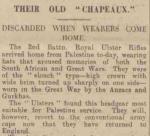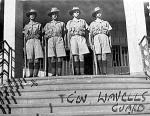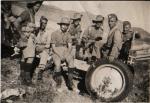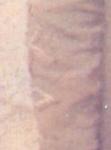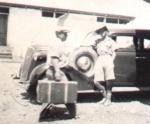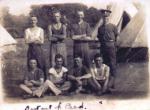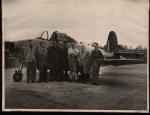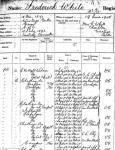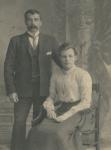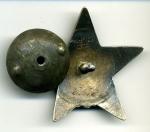
SMLE
Past Contributor-
Posts
29 -
Joined
-
Last visited
Content Type
Profiles
Forums
Blogs
Gallery
Events
Store
Everything posted by SMLE
-
Photo - Palestine 1937-39
SMLE replied to SMLE's topic in Great Britain: Militaria: Badges, Uniforms & Equipment
And just to answer my own question again; looks like the gun is a 3.7 inch QF Howitzer. They seem to have been used quite a lot in Palestine. Another a quote from the RUR history: "The work of patrolling the frontier was made very much easier by the timely arrival of "A" Squadron, 11th Hussars, and the Royal Navy in the form of three 3.7in. Howitzers, manned by personnel of H.M.S. "Repulse", H.M.S. "Malaya", and for a very short while by H.M.S. "Penelope"." I also attach a picture of some howitzers in action in Palestine. Interestingly it looks as if the barrel finishes just after the edge of my picture. Amazing what I have learnt from just one small photo that I have had for years but have obviously never looked closely enough at! Thanks all. Carl. -
Photo - Palestine 1937-39
SMLE replied to SMLE's topic in Great Britain: Militaria: Badges, Uniforms & Equipment
Hello again. For those of you "really" interested in what the British Forces in Palestine wore between the wars here are a couple more pieces of corroborating evidence. The History of the RUR Vol III has the following to say about their columns into the desert after the Arab "armed gangs": "Hard tack rations were carried on the man, who was dressed in canvas overalls, with cardigan and waterproof sheet for use in cold or wet weather." That seems to tie in nicely with the dress of the men in side caps. Also please see the article attached from the Nottingham Evening Post of April 12th 1939 for more about the slouch hats. As for the gun, it seems to be too small for a 25 Pdr. More like the size of the 18 Pdr from WW1. It looks new in the photo, perhaps an updated version? I presume this sort of gun wouldn't normally be integral to an infantry battalion? -
Photo - Palestine 1937-39
SMLE replied to SMLE's topic in Great Britain: Militaria: Badges, Uniforms & Equipment
Hello again. Looks like I have managed to solve this mystery. While searching for photos of the Royal Ulster Rifles in Palestine I came across the photos attached on a BBC website dedicated to WOII Billy Martin RUR and his wife Nellie. Billy served in the RUR from the end of WWI through to the end of WWII. In the 1930s he was in Palestine where the photos were taken. The captions are "Billy Martin circa 1938, went to France in WWII and came out via Dunkirk" and "General Wavell's Guard - at Mount Canaan, Billy Martin far left. Who are the others?" So it looks as if the RUR were wearing side caps with service dress in the 30s and given that the uniforms with slouch hats in my photo are exactly the same as the RUR members of Gen Wavell's Guard it seems that all of the troops with the field gun are British, possibly even all RUR. To be honest it was staring me in the face as in the smaller picture of my grandfather he is wearing the exact uniform , minus webbing, of the "Australians" in the other photo and now of Wavell's Guard, I just couldn't get past the fact that they must be "Australian". It looks as if the other troops in the field gun photo are wearing overalls over their service dress with side caps, so perhaps they were on some sort of working party hence the difference in dress? I suppose I will never know all the details but I'm happy now the photos are from Palestine 1937-39. Makes them even more interesting! So the next question is can anyone identify the gun, 25 Pdr? And would an infantry unit have something like this or would some of the men likely be artillery? Thanks again! -
Photo - Palestine 1937-39
SMLE replied to SMLE's topic in Great Britain: Militaria: Badges, Uniforms & Equipment
Hello Odulf. I was aware the British also wore the slouch hat and did think perhaps they were not Australian troops but they look so Australian! So I suppose a more general question is did British forces in Palestine wear the slouch hat or side cap and could all these men be British? The cap badge is RUR and he was with the LIR in North Africa/Italy, he was with the RUR pre war and with the BEF in France. Most of the men also have the look of older regulars rather than the younger WWII conscripts. Thanks for your help. Carl. -
Photo - Palestine 1937-39
SMLE replied to SMLE's topic in Great Britain: Militaria: Badges, Uniforms & Equipment
Hello Mervyn, thanks for the reply. I agree with you, and am 90% certain that they are Australian troops. The others are Royal Ulster Rifles which is the cap badge you can see. The reason for my question is that the RUR and the London Irish rifles, the two units my grandfather served with, were never in theatre at the same time as Australian troops during the war. The setting seems to be Middle East/North Africa and my grandfather was with the RUR in Palestine from 1937-39. So the circumstantial evidence seems to point to Palestine, I was hoping for something more to go on from members knowledge. Confirmation there were Australian troops in Palestine in the 1930s would be good. Also some information ref when side caps were first used may help as most pictures from Palestine do seem to show peaked caps. Ref the smaller picture. Although he was in Algeria and Tunisia during the war with the London Irish Rifles the LIR never wore the slouch hat and I don't think he would have got away with wearing it. So again thinking Palestine and wondering if anyone had any information ref British Forces headress in the area at the time. Thanks again. Carl. -
Hello all, My grandfather, Edward Byrne was in the Royal Ulster Rifles between 1933 and 1946. He was in Palestine before the war, with the BEF in France in 1940, then with the London Irish Rifles through North Africa and Italy. I have several photographs I have inherited and I know some are pre-war, I assumed one showing an artillery piece and Australian troops was during WWII. However having spoken recently with Richard via his excellent site on the Irish Brigade it seems that there were no Australian troops with the 1st Army and by the time the London Irish Rifles arrived in North Africa none with the 8th Army either. He also pointed out the RUR cap badge rather than LIR which I thought may be down to them being attached personnel but adding it all together it does now look as if this photo too is pre-war. The problem I have is that I can't find records of Australians in Palestine during the Arab Revolt, though I have photos of them in WW1 and WW2. Also the photos of British troops I can find show them wearing peaked SD caps, steel or pith helmets. So can anybody positively ID this photo as being taken in Palestine by the background or uniforms and confirm the presence of Australian troops? I have also attached another very fuzzy picture showing him wearing a slouch hat. Again this would not have been standard wear for any of his wartime service and I know that some Palestinian police units did adopt the slouch hat for it's comfort and idea if British infantry in Palestine did so? Many thanks.
-
Diamond Shaped Arm Badge - WWI
SMLE replied to SMLE's topic in Great Britain: Militaria: Badges, Uniforms & Equipment
Just found this on a site ref service numbers that helps: So it looks like T/2.S.R/03154 means Special Reserve for 2nd Kitchener Army? I've found this ref the Special Reserve: So it looks like in 1914 my Great Grandad enlisted in the ASC Special Reserve for the 2nd Kitchener Army and the photo was taken during a period of training early in the war he was then mobilised into the King's Regiment at a later date and sent to France. Does that look right? -
Diamond Shaped Arm Badge - WWI
SMLE replied to SMLE's topic in Great Britain: Militaria: Badges, Uniforms & Equipment
Thank you Leigh. I always assumed that he was conscripted or volunteered later in the war but looking closely at the uniform etc it looks as if perhaps he joined earlier. I suppose he could have been in the ASC but as manpower got shorter he was either transferred or volunteered for the infantry and was then sent to France. So no star. The mix of volunteer badge, equipment and Long Lee rifle don't look like late war to me, but I'm no expert! I have seen photos of territorial battalions mobilised in 1914 armed with Long Lee Enfields. Perhaps the service number from the ASC is a clue. T/2.S.R/03154, the 03154 I presume is the regimental number but what about the T/2.S.R? Perhaps someone may have some info ref ASC unit designation and service numbers? Any help anyone can give would be much appreciated. Carl -
Diamond Shaped Arm Badge - WWI
SMLE replied to SMLE's topic in Great Britain: Militaria: Badges, Uniforms & Equipment
Thanks very much Stuart. I wonder if he was a pre war "territorial" as it's a volunteer badge. Did they continue issueing these to volunteers during the war? He's wearing 1908 pattern equipment and the rifle is not the SMLE. Looks like a Long Lee Enfield or Lee Metford. I don't know if they used them for training during WW1. Could this be a pre or very early war photo? His medal card only shows him entitled to War and Victory medals but the photo looks earlier than 1916 to me, perhaps he didn't go overseas until 1916 0r 17 and therefore he wasn't entitled to a star. I would be interested to hear from anyone with more knowledge than me! Thanks again. Carl -
Hello, Below is a photo of my Great Grandfather Private Victor Mark White ASC and Kings Liverpool Regt, died of wounds 25th Sept 1917 on the Somme. I think the photo shows him in ASC uniform and on his lower right arm I can see his marksman badge but below that there appears to be a diamond shaped badge I've never seen before. Could anybody help identify it for me? Here is a close up: Many thanks for your help. Carl
-
Royal Ulster & London Irish Rifles
SMLE replied to SMLE's topic in Great Britain: Research, Documentation & History
Found one more. Wearing a slouch hat. Not very good quality. Italy? Did British troops wear slouch hats in the European theatre? The only other option is Palestine 1937. -
Can anyone ID this aircraft for me please?
SMLE replied to SMLE's topic in Great Britain: Research, Documentation & History
Thanks again Garth. Just got more of the story; apparantly he made the frame that the original picture stands in from cockpit plexiglass from the aircraft. The fact that he made the frame to display that particular picture I think shows he must have worked on it. Carl. -
Can anyone ID this aircraft for me please?
SMLE replied to SMLE's topic in Great Britain: Research, Documentation & History
Thanks Garth! So the family story is right, it was a secret prototype, the first British jet aircraft and one of only two ever built. Looking at the markings it seems to be initial prototype W4041 which is now in the science museum. I was there only the other week and didn't know. Apparently my wife's grandfather was a carpenter who worked on prototype aircraft during the war, I don't know if you'd need a carpenter for this one and if he worked on it or whether it was just a good chance for a photo. Any ideas, did they use wood at all? Thanks again. Carl -
Royal Ulster & London Irish Rifles
SMLE replied to SMLE's topic in Great Britain: Research, Documentation & History
Cont... The next one is a bit more interesting. I think it must have been taken in North Africa after he was attached to the 2nd London Irish Rifles. Seems to be an Australian artillery unit, twenty pounders? The British troops wear the side cap and I believe that the LIR wore the Caubeen, could these men be attached RUR men who kept the side caps I believe? I don't think it's pre war Palestine: Thanks for looking so far, I've got his pay book and roll call book with some interesting entries for North Africa which I will post if anyones interested. Carl -
Royal Ulster & London Irish Rifles
SMLE replied to SMLE's topic in Great Britain: Research, Documentation & History
Cont... I think this one must be late thirties looking at the uniforms. Perhaps on exercise somewhere. The rear says "with the signals section": -
Hello, My grandad (Cpl Edward Byrne) was in the Royal Ulster Rifles from 1933 to 1945. He served in Palestine in 1937 and was with the BEF in 1940 and was evacuated at Dunkirk. He was then attached to the London Irish Rifles for the Torch Landings, was wounded in North Africa but stayed with the Irish Brigade throughout the Italian Campaign. I've a few photos and I'd like to post them and see if my assumptions ref them are correct. Thanks in adavance for your help. A portrait shot, not much to say other than taken just after Dunkirk I think:
-
Hello, The photograph below shows my wife's grandfather (in the centre) who was employed as a carpenter at Farnborough during the war. Can anyone identify the aircraft in the picture? The family story has it that it was in development and it was strictly against orders for them to take any photos of the aircraft. They don't seem too worried though do they! Many thanks for your help. Carl
-
The Royal Marines
SMLE replied to leigh kitchen's topic in Great Britain: Militaria: Badges, Uniforms & Equipment
Cont... Fred served his over 22 years as a private apart from a 3 week period in June 1900 when he made the heady rank of Lance Corporal. He amassed 5 good conduct badges and the LSGC medal. He seems to have spent much of his time at Deal employed as a groom to various officers including J H Swanton the Colonel Commandant, his marriage certificate in 1904 shows him as a carriage driver! I hope this has been of interest. Compared to some of the RMLI records I've seen with numerous promotions, demotions and courts martial his seems fairly mundane! Carl -
The Royal Marines
SMLE replied to leigh kitchen's topic in Great Britain: Militaria: Badges, Uniforms & Equipment
Cont.. On 17th July 1914 Fred was "Discharged having completed 21 years service". This was not the best date to be discharged from the services and barely having made it to 2 weeks as a civilian Fred was recalled on 2nd August 1914. He served at Deal until 9 Nov 1915 when he was "Discharged Invalided" due to his failing eyesight. Interestingly Fred was one of the first servicemen to be assisted by the St Dunstan's charity for blind ex servicemen and his family were extremely gratefull for the help. They named one of their sons, my wife's grandfather, Arthur Dunstan White and he was always known as Dunstan. Keeping the tradition going we've given our son the middle name Dunstan, I'm sure he'll thanks me for it hen he's older! -
The Royal Marines
SMLE replied to leigh kitchen's topic in Great Britain: Militaria: Badges, Uniforms & Equipment
Following on from the above, Fred White joined the RMLI in 1893 and served over 22 years until 1915. He served in several ships initially, including HMS Penelope which was the Guard ship at Simonstown at the Cape of Good Hope and aboard the battleship HMS Canopus during her service with the Mediteranian fleet. In 1903 he returned to the RMLI Depot at Deal where he spent the rest of his service. -
The Royal Marines
SMLE replied to leigh kitchen's topic in Great Britain: Militaria: Badges, Uniforms & Equipment
Hello Saint, My Wife's Great Grandfather Frederick White was in the RMLI between 1893 and 1915. Below is the only picture we have of him. However I do think he bears a striking similarity to the private in your post. The shape of the nose and nostrils, the eyebrows one arched the other straighter, the shape of the eyes, one ear sticking out the other flat and the width of the neck. The only thing that seems a bit out is the earlobes to me. He was at Walmer in 1894 where your picture was taken and at Deal a mile or two up the coast between 1903 and 1915. My picture was taken in about 1914 so twenty years or so and the camera angles could account for the differences I think. Do you have any more details on your photo? I'll post some extracts of his service record below for anyone that is interested. Many thanks. Carl -
Soviet Researching Soviet Awards
SMLE replied to SMLE's topic in Russia: Soviet Orders, Medals & Decorations
Thanks for the reply. I know it's a bit late really but I saw some of the posts on here where people have researched awards and had never thought it was possible in the past. Peeked my interest. Is there anything further that can be gleaned? Thanks again. -
Soviet Researching Soviet Awards
SMLE replied to SMLE's topic in Russia: Soviet Orders, Medals & Decorations
http://gmic.co.uk/uploads/monthly_07_2009/post-7146-1247330038.jpghttp://gmic.co.uk/uploads/monthly_07_2009/post-7146-1247330055.jpg Thanks for any help. -
I wonder if anyone can help. Is there a way to research the following awards. I sold these a couple of years ago but have always wondered if there is a way of finding out who they were awarded to. Serial Nos: Red Banner 353037 Red Star 2267212 Many thanks.



